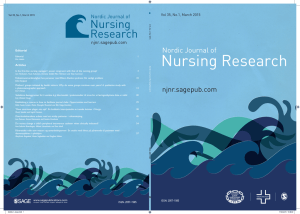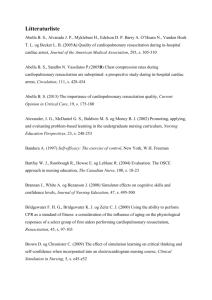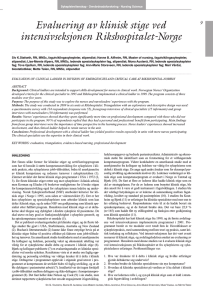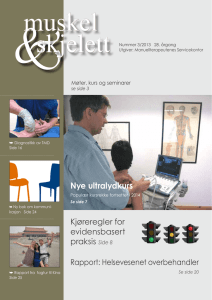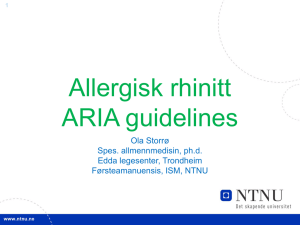What is evidence?
advertisement
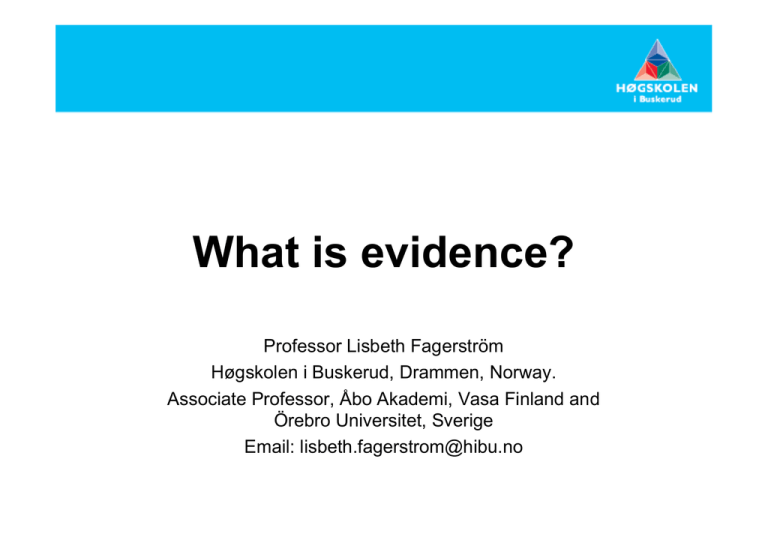
What is evidence? Professor Lisbeth Fagerström Høgskolen i Buskerud, Drammen, Norway. Associate Professor, Åbo Akademi, Vasa Finland and Örebro Universitet, Sverige Email: lisbeth.fagerstrom@hibu.no Evidens – naturens hälsoeffekt Varför evidens baserad vård? Fel behandling och vård Utebliven vård –’Icke vård’ • 20% av alla patienter upplever att de får felbehandling i alla land som är undersøkt • 30-40 prosent av patienterna får inte behandling i linje med vetenskapliga resultat • 20-25 prosent av all behandling är onödvändig, eller kan vara skadlig • Situationen i Norge: Ca 1000-2000 dödsfall Ca 15.000 långvariga skador Schuster, McGlynn, Brook (1998). Grol R (2001). Evidence Based Practice • Evidence-based medicine has been described as ‘the conscientious, explicit and judicious use of current best evidence in making decisions about the care of individual patients.’ • The practice of evidence-based medicine means integrating individual clinical expertise with the best available external clinical evidence from systematic research’ (Sackett et al. 2000). EB Nursing expands the above definition to include patient preferences and clincial expertise as sources of evidence. Vad räknas som evidens? • what constitutes a sufficient source of evidence and do different knowledge sources for evidence exist? • What should be considered evidence and in what circumstances? Källor för evidens • Various knowledge sources for evidence exist, including research, clinical experience, life experiences, patients/clients/carers, local context and environment. • In the delivery of evidence-based health care, research evidence has been prioritized. • As interest in person-centred care has been emphasized, clinical experience and life experiences have gained more attention. • Even the context of care has been defined as a knowledge source for evidence. Locally collected data may also have an important role to play in the development of evidence-based care. • A rather new trend is participatory research: when end-users (patients) are given the opportunity to collaborate in research projects. Nierse CJ et al (2011). Collaboration and co-ownership in researc: dynamics and dialogues between patient research partners and professional researchers in a rsearch team. Health Expect. 17, Online published. • According to Pearson (2002) and the Joanna Briggs Institute, evidence-based nursing leads to fewer variations in practice, cost savings that flow from appropriate product use and best health outcomes, and improvements in health outcomes in general. • A rather new trend is participatory research: when end-users (patients) are given the opportunity to collaborate in research projects. Even the context of care has been defined as a knowledge source for evidence. Locally collected data may also have an important role to play in the development of evidencebased care. • The FAME Scale can be used to evaluate evidence for practice; evidence should extend to issues relating to the feasibility, appropriateness, meaningfulness and effectiveness of interventions and activities. • Defined so, qualitative research constitutes legitimate evidence. Still, best practice should reflect the whole range of evidence available – both quantitative and qualitative. Användbarhet-LämplighetMeningsfull-Effektiv Pearson A. 2002. Nursong takes the lead. Reflections on Nuring Leadership, Fourth Quarter, 17-20. Kunskapsbaserad praxis Å utøve kunnskapsbasert praksis er å ta faglige avgjørelser basert på systematisk innhentet forskningsbasert kunnskap, erfaringsbasert kunnskap og pasientens ønsker og behov i den gitte situasjonen. Nortvedt MW, Jamtvedt G, Graverholdt B, Reinar LM, 2007 Forskningsbasert kunnskap Erfaringsbasert kunnskap Kunnskapsbasert praksis Kontekst Brukerkunnskap og brukermedvirkning Jamtvedt, kunnskapssenteret.no Tredimensionell kunskapssyn Fagerström L. (2011). Den tredimensionella kunskapssynen som epistemologisk grundsyn. I: Fagerström L. (red). Avancerad klinisk sjuksköterska. Avancerad omvårdnad i teori och proxis., s. 60. Studnetlitteratur, Lund. Barriers and facilitators in regard to the utilization of research in nursing practice. • In developing health care, evidencebased management is also needed. • Organizational support is an important factor when using research evidence in practice. • Leaders are responsible for creating a culture that promotes evidence-based practice and the continuous improvement of competence. Barriers to using research evdience in nursing practice • Accessibility (tillgänglighet) of research findings • Anticipated (förväntad) outcomes of using research • Organizational support to use research • Suuport from others to use research (organizational support most important) Retseas A. 2000. Barriers to using research evdience in nursing practice Journal of Advanced Nursing, 31, 599-606 Individual determinants of reserach utilization The aim of the review: to examine individual characterstics of nurses and how they influences reserach use. Results: • Beliefs and attitudes • Involvemenet in reserach activities • Information seeking • Professional characterstics • Education and oterh socio-economic factors Estabrooks et al. 2003. Individual determinants of reserach utilization: a systematic review. Journal of Advanced Nursing 43, 506-520. Sjuksköterskeresursser og patient outcome/resultat • Internationell forskning har påvisat att sjuksköterskeresurser har ett klart samband med kvalitetsindikatorer, resultat och mortalitet. • För få sjuksköterskor leder till en ökning av omvårdnadssensitiva (nursing sensitive quality indicators) kvalitetsproblem så som trycksår, sårinfektioner, fall, läkemedelsavvikelser samt ökad mortalitet. • Att utgå ifrån standardiserade nurse/patient ration (ex 0,8 Nurse/Patient) är inte förenligt med en vårdsyn där patientens tillfredsställelse med vården är central samt att varje patients behandling når uppställda resultatmål. 19 Workload and care quality problems • • Aiken, Clarke, et al. (2002) – Journal of the American Medical Association (2002) • Surveyed nurses about staffing and work environment in Pennsylvania, linked surveys to discharge data • Poor nurse staffing associated with higher: 30-day mortality, failure to rescue Needleman, Bauerhaus, et al. (2001) – Report for Health Resources and Services Administration – Companion article in New England Journal of Medicine (2002) – Use of administrative hospital data from states – Key outcomes associated with nurse staffing: • Urinary tract infections, pneumonia • Length of stay • Upper gastrointestinal bleeding • Shock, failure to rescue 20 Sykepleieresursser og patient outcome/resultat • I tidigare forskning har dessa samband påvisats genom att utgå ifrån personår relaterat till antal patienter och kvalitetsproblem. • Ingen internationell forskning finns där personalbehovet utgår ifrån den enskilda patientens dagliga vårdbehov och behov av omvårdnadsinsatser. Needleman J. et al (2011). Nurse Staffing and Inpatient Hospital Mortality. The New England Journal of Medicine 364;11, 1037-1045. Aiken et al (2010). Implications of the California Nurse Staffing Mandate for Other States. Health Services Research, 45 (4), p. 904–921. 21 RAFAELA-systemets uppbyggnad OPC = pat:s pleietyngd 6-24 p/pat Personalresurser = antal sköt som vårdat pat PAONCIL Bedömning av personalresurser i relation till det optimala Pleietyngd/nurse Optimala pleietyngdsnivån Regressionsanalys 22 HVORFOR TRENGER VI MÅLNING AV SYKEPLEIEINTESITET? A. For å sikre behandlingsresultat/outcome • for systematisering av sykepleiens innehold • for analys og kvalitetsutvikling av sykepleie • For å garantere pasientsikkerhet/patient safety • Utvikler sykepleiedokumentasjon • For evaluering av pleie og omsorg til pas. • En del av verksamhetsuppföljningen Aiken et al (2010). Implications of the California Nurse Staffing Mandate for Other States. Health Services Research, 45 (4), p. 904–921. 23 HVORFOR TRENGER VI MÅLNING AV SYKEPLEIEINTESITET? B. For optimal resurshåndtering C. Metode for kunskapsbasert ledelse • Sykepleieintensitet en sentral del virksomheten som helhet • bakgrunnsdata for analyse av virksomheten og for beslutt • bakgrunnsdata for kommunikasjon med ansvarlige beslutningstagare • for å garantere en balanse mellom pasientenes helsebehov og personalresurser Fagerström L. 2009. Evidence-based human resource management: a study of nurse leaders' resource allocation. Journal of Nursing Management, 17, 415–425. Ledarskapets betydelse ’Change management and clinical leadership are cruicial for Evidence Based Practice.’ Source: Foundation of Nursing Studies. 2001. Taking Action: Moving Towards Evidence Based Practice – exectuive summary. Organisational infrastructures to promote evidence based nursing practice. Results: Organizational infrastructures may be important in the development of evidence based nursing practice. The Cochrane Collaboration. Foxcroft. D & Cole N. Organisational infrastructures to promote evidence based nursing practice. Cochrane database of Systematic Reviews 2003, Issue 4. Avancerad klinisk sjuksköterska ICNs definition av Advanced Practice Nurse: A registered nurse who has acquired the expert knowledge base, complex decision-making skills and clinical competencies for expanded practice, the characteristics of which are shaped by the context and/or country in which s/he is credentialed to practice’. En nordisk modell för Avancerad Klinisk Omvårdnad Fagerström L. (2011).En nordisk modell för Avancerad klinisk omvårdnad. I: Fagerström L. (red). Avancerad klinisk sjuksköterska. Avancerad omvårdnad i teori och proxis., s. 99. Studnetlitteratur, Lund. Hygiensjuksköterskan som AKS • God och säker vård • Expertroll, konsult, samarbete, etiskt beslutsfattande • Ledaruppgift • Forskning och utveckling • Direkt klinisk praxis? • Rätt att ordniera ordinera mediciner, ge vård och behandlingsföreskrifter? Tack och Lycka till!
